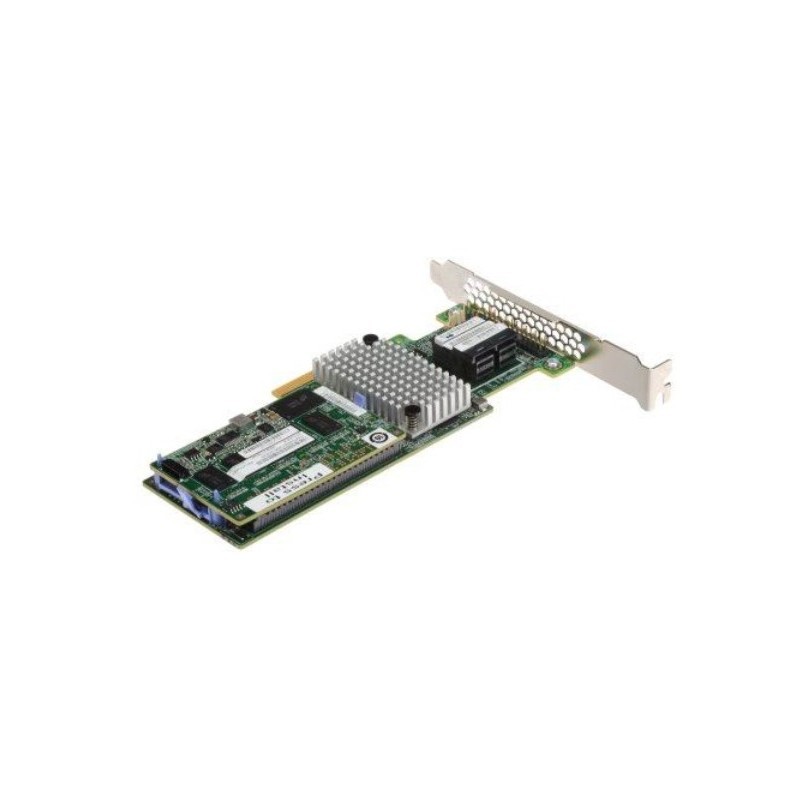
Features
The ServeRAID M5210 and M5210e SAS/SATA controllers have the following standard features:
- Auto-resume on array rebuild or array reconstruction after the loss of system power
Auto-resume uses non-volatile RAM (NVRAM) to save the rebuild progress during a host reboot or
power failure to automatically resume from the last checkpoint. Auto-resume ensures that data
integrity is maintained throughout the process. The card supports a number of features that can be
implemented without rebooting the server. Applications, such as email and web server, benefit from
avoiding downtime during the transition.
- Online Capacity Expansion
Online Capacity Expansion (OCE) allows the capacity of a virtual disk to be expanded by adding new
physical disks or making use of unused space on existing disks, without requiring a reboot.
- Online RAID Level Migration
Online RAID Level Migration, which is also known as logical drive migration, can migrate a virtual
disk from any RAID level to any other RAID level without requiring a reboot. System availability and
application functionality remain unaffected.
- Fast initialization for quick array setup
Fast initialization quickly writes zeros to the first and last sectors of the virtual drive. This feature
allows you to immediately start writing data to the virtual drive while the initialization is running in the background.
- Consistency check for background data integrity
Consistency check verifies that all stripes in a virtual disk with a redundant RAID level are consistent. The consistency check mirrors data when an inconsistent stripe is detected for RAID 1 and re-creates the parity from the peer disks for RAID 5 or RAID 6. Consistency checks can be scheduled to take place periodically.
Extensive online configuration options and advanced monitoring and event notification
Management tools provide convenience for the configuration of logical volumes and alerting when
errors have occurred or are about to occur.
Patrol read for media scanning and repairing
Patrol read is a background sentry service that pro-actively discovers and corrects media defects
(bad sectors) that arise normally as a disk drive ages. The service issues a series of verify
commands, and if a bad block is discovered, the card's firmware uses RAID algorithms to re-create
the missing data and remap the sector to a good sector. The task is interruptible based on controller activity and host operations. The firmware also provides an interface where the patrol read task can be initiated, set up for continuous operation, and terminated from a management application. Patrol read can be activated by a manual command or automatically.
- Global and dedicated hot spare with revertible hot spare support
A hot spare rebuilds data from all virtual disks within the disk group in which it is configured.
ServeRAID can define a physical disk as a hot spare to replace a failed drive. Hot spares can be
configured as either global or dedicated. A global hot spare allows any physical drive to be
designated as a hot spare. A dedicated hot spare allows the user to assign a hot spare drive to a
particular array of the same drive type.
Drive roaming
Drive roaming occurs when the physical disks are changed to different ports on the same controller.
When the drives are placed on different channels, the controller detects the RAID configuration from
the configuration data on the drives.
The ServeRAID M5210 and M5210e SAS/SATA controllers have the following standard features:
- Auto-resume on array rebuild or array reconstruction after the loss of system power
Auto-resume uses non-volatile RAM (NVRAM) to save the rebuild progress during a host reboot or
power failure to automatically resume from the last checkpoint. Auto-resume ensures that data
integrity is maintained throughout the process. The card supports a number of features that can be
implemented without rebooting the server. Applications, such as email and web server, benefit from
avoiding downtime during the transition.
- Online Capacity Expansion
Online Capacity Expansion (OCE) allows the capacity of a virtual disk to be expanded by adding new
physical disks or making use of unused space on existing disks, without requiring a reboot.
- Online RAID Level Migration
Online RAID Level Migration, which is also known as logical drive migration, can migrate a virtual
disk from any RAID level to any other RAID level without requiring a reboot. System availability and
application functionality remain unaffected.
- Fast initialization for quick array setup
Fast initialization quickly writes zeros to the first and last sectors of the virtual drive. This feature
allows you to immediately start writing data to the virtual drive while the initialization is running in the background.
- Consistency check for background data integrity
Consistency check verifies that all stripes in a virtual disk with a redundant RAID level are consistent. The consistency check mirrors data when an inconsistent stripe is detected for RAID 1 and re-creates the parity from the peer disks for RAID 5 or RAID 6. Consistency checks can be scheduled to take place periodically.
Extensive online configuration options and advanced monitoring and event notification
Management tools provide convenience for the configuration of logical volumes and alerting when
errors have occurred or are about to occur.
Patrol read for media scanning and repairing
Patrol read is a background sentry service that pro-actively discovers and corrects media defects
(bad sectors) that arise normally as a disk drive ages. The service issues a series of verify
commands, and if a bad block is discovered, the card's firmware uses RAID algorithms to re-create
the missing data and remap the sector to a good sector. The task is interruptible based on controller activity and host operations. The firmware also provides an interface where the patrol read task can be initiated, set up for continuous operation, and terminated from a management application. Patrol read can be activated by a manual command or automatically.
- Global and dedicated hot spare with revertible hot spare support
A hot spare rebuilds data from all virtual disks within the disk group in which it is configured.
ServeRAID can define a physical disk as a hot spare to replace a failed drive. Hot spares can be
configured as either global or dedicated. A global hot spare allows any physical drive to be
designated as a hot spare. A dedicated hot spare allows the user to assign a hot spare drive to a
particular array of the same drive type.
Drive roaming
Drive roaming occurs when the physical disks are changed to different ports on the same controller.
When the drives are placed on different channels, the controller detects the RAID configuration from
the configuration data on the drives.
| Certification | UL, cUL, IEC60950, EMC, FCC, TUV, CE, VCCI, BSMI, C-tick, KC |
| Data transfer rate | 12 Gbit/s |
| Host interface | PCI Express x8 |
| Internal memory type | DDR3 |
| Mac operating systems supported | Yes |
| Maximum capacity | 2 TB |
| Operating temperature (T-T) | 5 - 40 °C |
| Package dimensions (WxDxH) | 143 x 238 x 51 mm |
| PCI Card form factor | half-height (low-profile) |
| RAID levels | 0, 1, 10 |
| S.M.A.R.T support | Yes |
| Supported hard disk drive interfaces | SAS, Serial ATA |
| Weight | 99 g |
| Width | 69 mm |
| Windows operating systems supported | Yes |
Lenovo 46C9110
ServeRAID M5210 SAS/SATA Controller
46C9110
Out of Stock
£456.25
£380.21 Ex VAT. 

